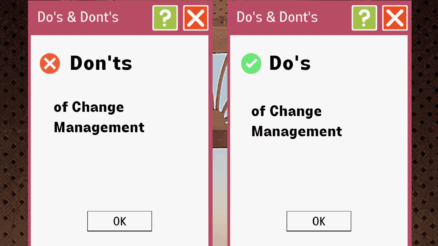Communication channels are simply different means through which you can communicate with others in an organization.
Internal communication is very important for functioning of every business and workplace because team exchanges ideas and information and collaborate through ways of internal communication.
For every internal communication, channels are required to share information, ask or respond to questions and announce news and updates. This could be done in person, over the phone, or virtually via email, social networks, or instant messaging.
In this blog, we’ll discuss importance of using right communication channel for change management and what are those effective 08 communication channels for change management that are trusted by change leaders and managers.
Importance of using the right communication channel for change management
Communication channel is a medium through which message is sent across.
As it is said that “the medium is the message”.
Why?
Because the nature of selected medium or channel can influence the meaning of a message.
If a change leader selects an wrong medium through which important information is transmitted to employees or stakeholders, then it may result into different interpretation of information and it may cause failure of transmitting information or message.
One channel does not fit all when communicating change in the organizations.
We understand that some people require information in a different format to comprehend it properly. Once change information has been developed, make several communication pathways and channels available for use in change communication.
It may be helpful to categorize your communication channels into two groups: external and internal channels.
Customers, prospects, suppliers, and investors are examples of people who use external channels to communicate with your organization. Internal channels are for communicating with your employees and departments within your organization.
Not all communication channels are considered equal. While each has its own set of advantages, some modes of communication are naturally stronger and effective for powerful dialogue and discussion whereas others allow one-sided detailed communication.
It’s important for a change leader and manager to identify right kind of channel to communicate their message across.
what are 08 communication channels for change management
Organizations must avoid making the costly mistake of simply relying on one communication channel, such as e-mail or the company website.
Different research and modern experience suggests us to use 08 communication channels for change management.
Let’s discuss these in detail:
1. Staff Meetings
Face-to-face meetings are one of the best communication channels available in workplaces.
These are usually regarded as the most effective way to communicate organizational change.
Why?
Because it allows face-to-face conversation on complex and sensitive issues of change. Staff meetings also provide opportunity to have a two-way communication.
It allows both verbal and non-verbal communication. Among the non-verbal communication method, body language, facial expressions, tone of conversation are most important as these help to further clarify message and reduce misinterpretations.
These meetings can be organised in informal and formal settings and its can be of short duration of time and also long depending what type of details of organizational change needs to be discussed.
Therefore, staff meetings should be organised regularly during the time of change because employees need to know about change and they also want to discuss their concerns. So, change leaders must focus on having open and candid feedback through these meeting.
2. Town Hall Meetings
Town Hall meetings are arranged when leadership or management wants to talk to all of employees. It can be organised in a big hall or it can be held virtually through Zoom or any other video conference tool.
The purpose of town hall meetings is have a direct communication between management and all tier of employees and keep them informed about key changes. They support the team in asking questions and providing feedback about the organizational change.
These meetings have their own benefits like the latest information on the change project is presented directly. A message of change from the organization’s leader delivered in person will have more impact than one delivered via email.
Employees are involved in entire organizational change process. It makes them feel like they have a voice in the decision process.
Due to hybrid work culture, organizations can arrange town halls meetings through video conferencing tools. A virtual town hall meetings are more common nowadays because it allows everyone to join meeting and get involved in change process.
3. Panel Discussion
Panel discussions are a hallmark of today’s meetings and seminars, even online ones. A panel discussion’s objective as a communication channel in organizational change is to inspire discussion among a group of experts and thought leaders so that employees can learn from their discussion and involvement.
Any panel discussion should ideally be covering three quality aspects to ensure effective communication for change:
- The discussion should be enlightening and thought-provoking.
- It should present a variety of viewpoints about organizational change.
- It inform, inspire, and excite the interest of employees in organizational change.
The best panel discussions are those that are centered on single topic. Panelists should be experts of the subject within or outside of organization who can generate interesting discussion.
The moderator of panel discussion is also vital for a successful panel discussion because he/she may not be that expert of subject but must have ability to handle experts and keep discussion on track and achieve communication objectives within limited time.
4. Microsite on change
Organizations can build a small website or web page to communicate with their employees and other key stakeholders about change initiative and process.
This microsite is used to explain employees about change, announce important news and updates, inform them about events. Different resources and toolkits and information about skills development are also made available on such microsite.
Organizations usually use different or subdomain to build a separate microsite on change management. But it is linked with the main domain of organizations.
There is a section on FAQs on change process which help employees to have answers to their questions. Employees can ask specific questions by submitting these to microsite and management can respond to these.
To ensure effective two-way communication, make sure you have a robust mechanism in place for delivering replies quickly. You wouldn’t want employees to feel as if their questions have vanished into thin air.
5. Focus Group Discussions
A focus group discussion brings together employees from comparable backgrounds or experiences to discuss a specific issue of interest.
Focus groups allow a group of people to discuss single issue in detail and share their insight and opinions and perspective on it.
The following are some of the benefits of focus groups in organizational change:
- Help management to understand attitude and perception of employees towards change
- Have insights and suggestions from employees on execution of change
- Discover concepts and concerns related to the change process that may not have been explored at first but are critical to the organization’s success.
Focus group discussion should be moderated by an expert of subject and who have moderation skills to keep discussion moving among participants. In such discussions, employees feel more comfortable to share their views and express their feedback without any fear.
6. Continuous email updates
Email is generally the best communication when you need a to send quick updates about change but don’t want to waste time with scheduling face-to face meetings.
This method of communication is ideal for transmitting structured official announcements of organizational change, especially when conveying important messages down the chain of command.
You can often address the significance of a message by flagging it as urgent when communicating with your team via your business email address.
You can utilize emails as a communication channel for organizational change in the following ways:
- To provide team members with progress updates on the change process
- To share important information like change management strategies with the employees
- To provide the staff of the organization with regular updates on the transformation process.
7. Social Media
Organizations are only now beginning to use social media as a change communication tool. While social media is most commonly associated with engaging with individuals outside of the workplace, LinkedIn Groups and Facebook Groups offer organizations new ways to improve team communication.
Internal networking and culture-building can be facilitated by less formal company communication of any change through social media groups.
While you won’t be able to reach everyone without using social media accounts, these groups are useful for delivering reminders about previously announced events or any change that the company is undergoing. Notifications are built-in, allowing you to reach out to a large number of people in one fell swoop.
8. Toolkits for Change Managers
It’s important that leadership throughout the organization be communicating a consistent message.
Change managers must be prepared for communicating messages on change and know how to answer employees’ questions.
For this to happen, special resource material like talking points, FAQs, power point presentations, fact sheets can be provided to change managers. All this materials can be packaged into a single communication toolkit that will be helpful to make communication easier and more effective.
A good toolkit equips change managers with latest knowledge and skills required to implement successful change and build their capacity to track performance related to implementation of change.
Final Words
Knowing how to employ the best communication channels for change management is crucial for success of change initiative. The practitioners and researchers describe 08 effective communication channels for change management. Every communication channel has its owns advantages and disadvantages. Change leaders must use them wisely for their benefit and avoid using wrong channel to minimise risk of failure of change communication.



